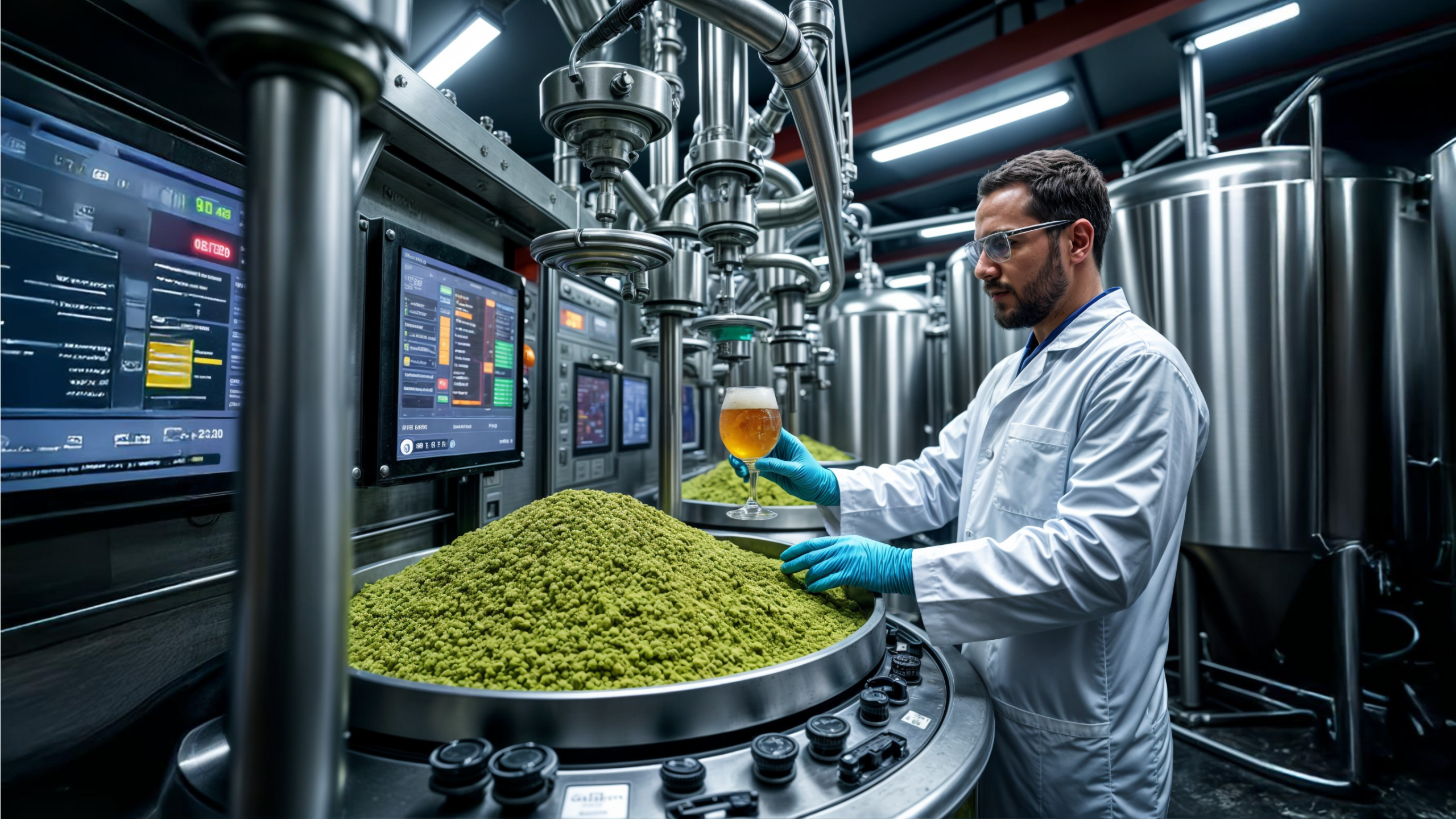Would you taste a beer brewed from pre-chewed grain? Did you know that brewing would be impossible without the smallest creatures ever domesticated? Can you imagine living in a world where the saying goes: “Don’t drink water; it can make you sick—drink beer instead!” And could you predict the taste of a beer just by knowing its ingredients and brewing process? Join us as we explore some beer history, brewing methodology, and cutting-edge technology in the 10,000-year-long journey of brewing—brought to you by AGRI-FOOD.AI!
From Chewing to Controlled Malting
The origins of beer can be traced back to ancient civilizations in the Fertile Crescent, the Nile Valley, and East Asia, where humans first began cultivating grains between 9,500 and 6,000 BCE. The transition from random fermentation of ripe or fallen fruits to a more controlled brewing process marked a significant technological advancement. This early brewing involved transforming cereal starch into sugar, often by chewing grains to release enzymes in saliva that converted starch to sugar. This method, still used in some traditional beer-making practices like the South American chicha, was eventually replaced by a controlled malting process. Malting involved soaking grains in water to start germination, which converts stored starches into sugars, followed by drying or heating the grains to stop germination, thereby producing malt that could be fermented.

The Role of Yeasts: The Smallest Creatures Ever Domesticated
A crucial factor in brewing is the fermentation process driven by yeasts, particularly Saccharomyces cerevisiae. This yeast species became specialized in metabolizing malt sugar—rarely found in the wild— turn the sugar into alcohol. The evolution of yeasts to utilize sugars effectively is thought to parallel human domestication of animals and plants. Early humans unknowingly selected for yeasts that produced pleasant beer characteristics. Fermentation was initially a spontaneous process, with brewers relying on the wild yeasts and bacteria naturally present in their environment. Over time, the practice of using “sediment” from previous batches to start new brews led to the domestication of specific yeast strains, giving each brewery a unique microbial fingerprint.
Ingredients and Techniques of Ancient Beers
Ancient beers were brewed using a mix of grains, often supplemented with additives like oak bark, honey, and fruit juices to initiate fermentation and add flavors. Archaeological evidence shows that early beers included ingredients like grapes, which lowered the pH of the wort and provided antimicrobial properties. This was beneficial for preserving the beer and enhancing its safety as a consumable liquid. In Mesopotamia, beer was often made by fermenting leftover bread, indicating a close link between bread-making and brewing. The use of sourdough starters rich in yeast for both bread and beer exemplifies the symbiotic relationship between these staples of early civilization.
Brewing in Different Cultures and Climates
Beer was generally more accessible and affordable than wine, which required specific climatic conditions for grape cultivation. Consequently, beer became the beverage of choice in regions where viticulture was challenging, such as Northern Europe. The climate significantly influenced the types of beers produced, with warmer climates posing challenges due to rapid fermentation and spoilage risks. Despite these difficulties, ancient brewers in the Fertile Crescent and Egypt achieved remarkable consistency in their brewing techniques, laying the groundwork for beer’s widespread popularity.
In contrast, the colder climates of Northern Europe fostered different brewing traditions. The Nordic cultures, while often depicted in literature as indulging in intoxication, were also skilled brewers. They contributed significantly to beer production with innovations like grut beers—a mixture of herbs and spices that acted as fermentation starters. However, these beers had a shorter shelf life compared to hop beers, which gained prominence from the 14th century onward due to their longer shelf life and easier standardization. Hops provided antimicrobial benefits, making beer more stable and less prone to spoilage.
Technological Advances in Brewing
The onset of the Little Ice Age in the 15th century saw the rise of lager brewing, characterized by the use of bottom-fermenting yeast strains like Saccharomyces pastorianus. This yeast strain, which thrives at lower temperatures, produced a cleaner and crisper beer. Lager brewing’s rise in colder regions led to innovations such as controlled fermentation temperatures, which improved the consistency and quality of beer. However, the existence of yeast and its role in fermentation remained a mystery until the scientific advances of the 17th century.
The Science of Fermentation
The scientific exploration of fermentation began in earnest during the late Middle Ages. Antoni van Leeuwenhoek’s pioneering work in the 17th century led to the discovery of microorganisms, including yeast, under the microscope. However, it was not until the mid-19th century that scientists like Theodor Schwann identified yeast as the key agent in fermentation. This period marked a significant turning point, as the scientific method enabled brewers to understand and control the fermentation process more precisely. The discovery of glycolysis and the metabolic pathways involved in fermentation paved the way for modern brewing technology.
The Shift to Modern Brewing Practices
The introduction of hops, advancements in yeast management, and the understanding of fermentation transformed brewing from a craft based on empirical knowledge to a science-driven industry. The spread of bottom-fermenting yeast strains led to the dominance of lagers, which are now the most popular beer style worldwide. The development of pasteurization and refrigeration in the 19th and 20th centuries further enhanced the stability and shelf life of beer, making it a globally distributed product.

The Chemistry of Brewing
The chemistry of beer brewing involves four main stages: malting, mashing, fermentation, and conditioning.
1. Malting
The journey begins with malted barley, which is dried, soaked in water, and allowed to germinate. During germination, the barley’s natural enzymes, primarily amylases, break down starches into simpler sugars like maltose. This process is halted by drying the malt, preserving the enzymes for the next stage.
2. Mashing
In mashing, the malt is mixed with hot water to create a mash. The temperature is crucial, typically maintained between 62°C and 72°C (143°F – 162°F). Here, enzymes continue to break down complex carbohydrates into fermentable sugars (mainly glucose, maltose, and maltotriose). Proteins are also broken down into amino acids, which will later serve as nutrients for the yeast. The mash is then filtered to produce a sugary liquid called wort.
3. Boiling and Hopping
The wort is boiled to sterilize it, which also stops enzyme activity. Hops are added during the boil, introducing alpha acids that isomerize into iso-alpha acids, which impart bitterness and act as natural preservatives. The essential oils in hops contribute aromatic compounds, adding depth to the beer’s flavor profile.
4. Fermentation
Once cooled, yeast is added to the wort, kicking off the fermentation process. The yeast, primarily Saccharomyces cerevisiae (for ales) or Saccharomyces pastorianus (for lagers), metabolizes the sugars, producing ethanol and carbon dioxide. The reaction can be summarized as:
C6H12O6→2C2H5OH+2CO2
This exothermic reaction also releases heat, which needs to be managed for optimal yeast activity.
5. Conditioning
Finally, the beer is conditioned, either in tanks or bottles, where the remaining yeast ferments any residual sugars. This process refines flavors and adds carbonation, resulting in a balanced and finished product ready for consumption.
Variations for one Theme
The basic process can be modified in many ways, to get more alcohol-heavy beers or to get smother, lighter ones. Adding extra ingredients can produce a variety of tastes.
1. Modifying Alcohol Content
a) Adjusting the Malt Bill
- Increase Alcohol: Using more malted barley or other grains increases the amount of fermentable sugars in the wort, resulting in a higher alcohol content after fermentation. Specialty grains like Munich or caramel malts can add body and sweetness along with more sugars.
- Decrease Alcohol: Using less malt or adding adjunct grains like rice or corn (which have fewer fermentable sugars) can lower the overall alcohol level. This produces a lighter, crisper beer.
b) Mash Temperature Control
- Increase Alcohol: Lowering the mash temperature (around 62°C/143°F) favors beta-amylase enzyme activity, which breaks down starches into simpler, highly fermentable sugars. This produces a drier beer with a higher alcohol content.
- Decrease Alcohol: Higher mash temperatures (around 70°C/158°F) favor alpha-amylase activity, creating more complex, less fermentable sugars. This results in a fuller-bodied beer with a lower alcohol content.
c) Yeast Selection
- High-Alcohol Yeast Strains: Some yeast strains, like Saccharomyces cerevisiae used for ales, can tolerate higher alcohol concentrations and convert more sugars into alcohol.
- Low-Alcohol Yeast Strains: Other strains, like Saccharomyces pastorianus used for lagers, ferment more slowly and can be stopped earlier to limit alcohol production.
d) Fermentation Time and Temperature
- Increase Alcohol: Longer fermentation times and slightly warmer temperatures (20-22°C/68-72°F) can boost yeast activity, resulting in higher alcohol content.
- Decrease Alcohol: Cooler fermentation temperatures (10-12°C/50-54°F) or shorter fermentation periods will produce a beer with lower alcohol content since the yeast’s activity slows down. for floral, citrus, or pine-like aromas, without increasing bitterness.
2. Modifying Taste
a) Hop Additions
- Bitterness: Adding hops early in the boil extracts more alpha acids, increasing bitterness. Hops like Cascade or Chinook are known for their high bitterness levels.
- Aroma and Flavor: Late hop additions or dry hopping (adding hops after boiling) preserve the volatile oils responsible for floral, citrus, or pine-like aromas, without increasing bitterness.
b) Malt Choice
- Sweetness and Body: Using specialty malts like caramel, chocolate, or roasted malts adds sweetness, richness, and complex flavors (e.g., toffee, caramel, or coffee notes).
- Dryness: Light malts like Pilsner or pale malts produce a lighter, drier beer with fewer residual sugars. flavor profile, ideal for lighter beers like Pilsners.
c) Adjunct Ingredients
- Fruity and Spicy Flavors: Adding fruits (e.g., cherries, raspberries), spices (e.g., coriander, cloves), or herbs during fermentation can introduce new layers of flavor.
- Sourness: Introducing lactobacillus bacteria or Brettanomyces yeast can create sour beers with tart and funky flavors. in a smoother and milder flavor profile, ideal for lighter beers like Pilsners.
d) Water Chemistry
- Hard Water: Rich in minerals like calcium and magnesium, which can enhance hop bitterness and add a sharper taste.
- Soft Water: Lacks minerals, resulting in a smoother and milder flavor profile, ideal for lighter beers like Pilsners.
e) Fermentation by-products
- Ester Production: Warmer fermentation temperatures can increase the production of esters, resulting in fruity notes like banana or pear (common in Belgian ales and Hefeweizens).
- Phenolic Compounds: Certain yeast strains, particularly those used in wheat beers, can produce phenols that impart clove-like or spicy flavors.
By carefully adjusting these variables, brewers can craft beers with precise levels of alcohol and tailored taste profiles, ranging from light and refreshing to strong and complex.
The Future of Brewing: A Digital Revolution
Curious about how these variables influence the final product? Enter the experimental BeerPredictor digital twin model developed by AGRI-FOOD.AI. This cutting-edge technology allows brewers to simulate and optimize recipes before brewing a single batch. Want to learn how it works? Tune into our latest podcast episode featuring Gergely Boromisza, who dives into this innovation, alongside insights from Gen Z agriculturalist Gergely Hankó on the future of brewing and agriculture.
And don’t forget to stick with us week after week!. Connect with us online fill out the form on our website, and we’ll get back to you ASAP. Send us your questions, share your experiences, and we’ll turn them into podcast with answers and solutions from the world of IT and AI technologies. Catch us on Spotify, Apple podcasts and YouTube. Subscribe to our channel to be the first to know when a new episode drops.
 2024-11-22
2024-11-22  PODCAST
PODCAST
 share
share


 Our website uses cookies
Our website uses cookies